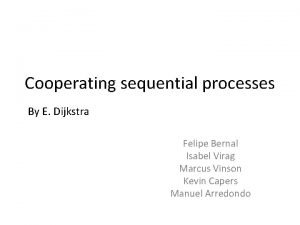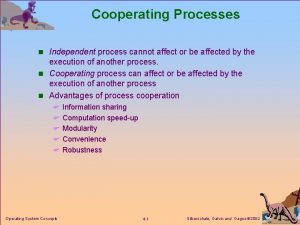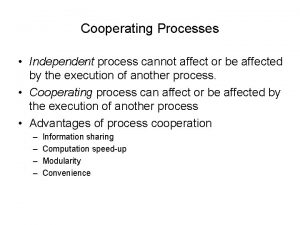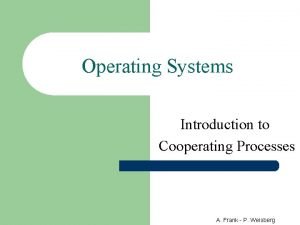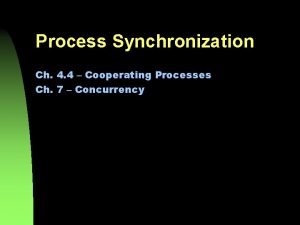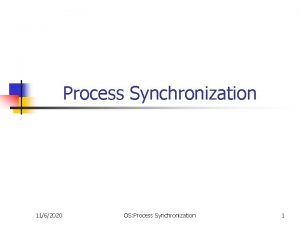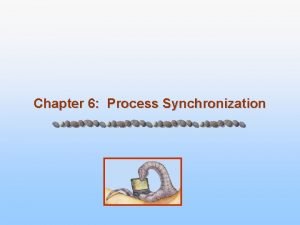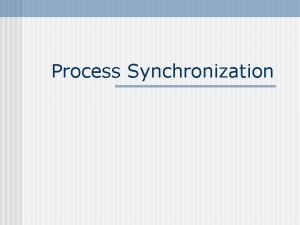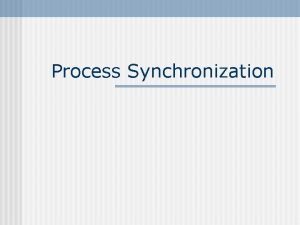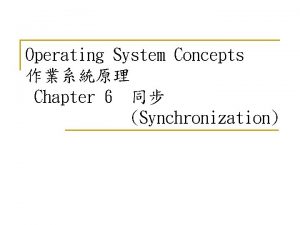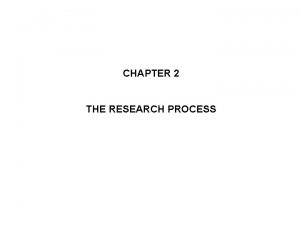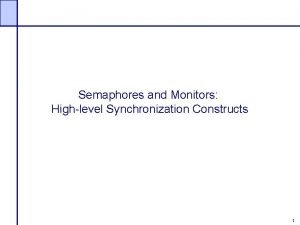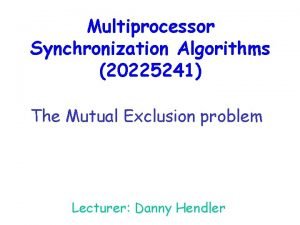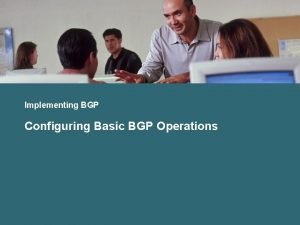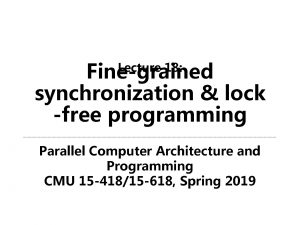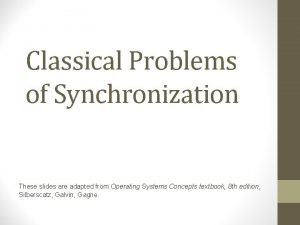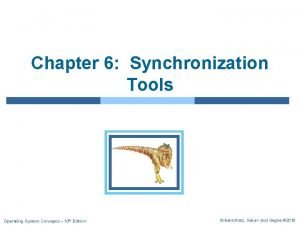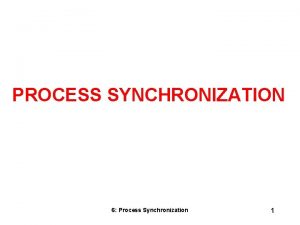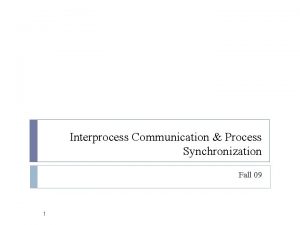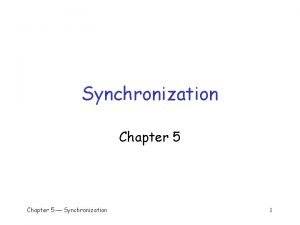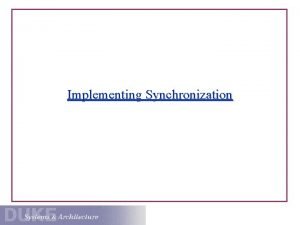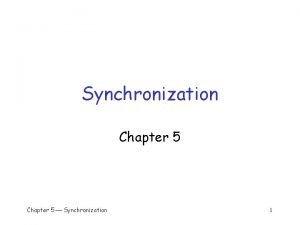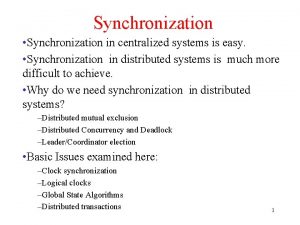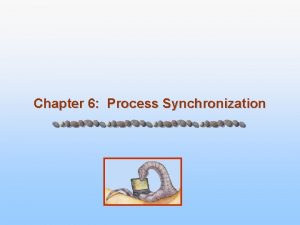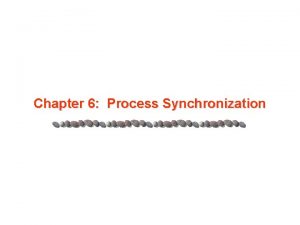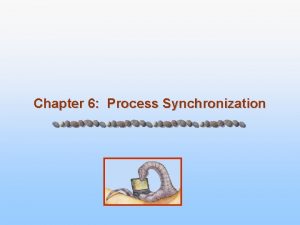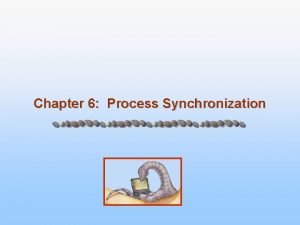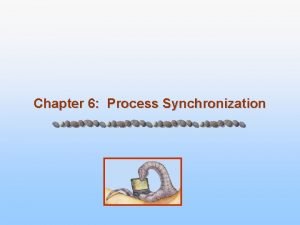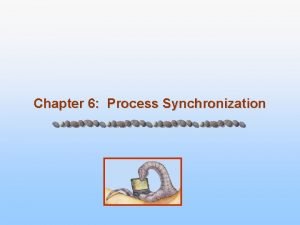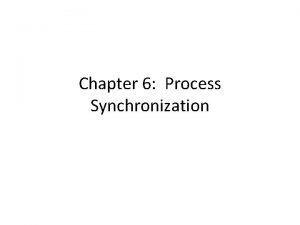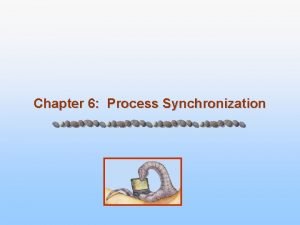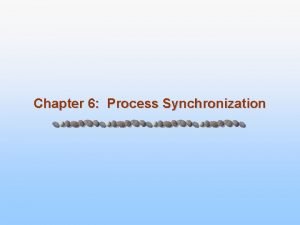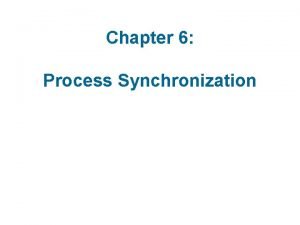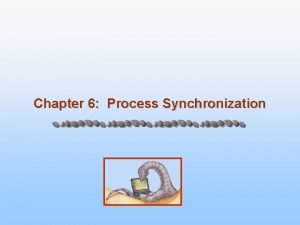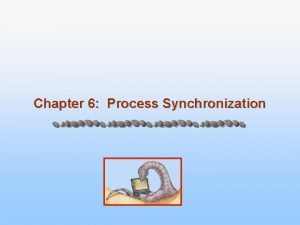Process Synchronization Ch 4 4 Cooperating Processes Ch






















- Slides: 22

Process Synchronization Ch. 4. 4 – Cooperating Processes Ch. 7 – Concurrency

Cooperating Processes § Independent process cannot affect or be affected by the execution of another process. § Cooperating process can affect or be affected by the execution of another process

Advantages of process cooperation § Information sharing • Allow concurrent access to data sources § Computation speed-up • Sub-tasks can be executed in parallel § Modularity • System functions can be divided into separate processes or threads § Convenience

Context Switches can Happen at Any Time § A process switch (full context switch) can happen at any time there is a mode switch into the kernel § This could be because of a: • • System call (semi-predictable) Timer (round robin, etc. ) I/O interrupt (unblock some other process) Other interrupt, etc. § The programmer generally cannot predict at what point in a program this might happen

Preemption is Unpredictable § This means that the program’s work can be interrupted at any time (I. e. just after the completion of any instruction): • Some other program gets to run for a while • And the interrupted program eventually gets restarted exactly where it left off. • After the other program (process) executes other instructions that we have no control over § This can lead to trouble if processes are not independent

Problems with Concurrent Execution § Concurrent processes (or threads) often need to share data (maintained either in shared memory or files) and resources § If there is no controlled access to shared data, execution of the processes on these data can interleave. § The results will then depend on the order in which data were modified • i. e. the results are non-deterministic.

Shared Memory process A shared memory process B kernel

An Example: Bank Account A joint account. Each account holder accesses money at the same time – one deposits, the other withdraws. The bank’s computer is executing the routine below simultaneously as two processes running the same transaction processing program void update(acct, amount) { temp = getbalance(acct); temp += amount; putbalance(acct, temp); }

Banking Example Initial balance = A’s deposit = B’s withdrawal = Net balance = $60 $100 $50 $110 void update(acct, amount) { temp = getbalance(acct); temp += amount; putbalance(acct, amount); } B’s process: A’s process: temp = 60 Process Switch! temp = 60 + 100 putbalance (160) Process Switch! temp = 60 - 50 putbalance (10) What is the final bank balance?

Race Conditions § A situation such as this, where processes “race” against each other, causing possible errors, is called a race condition. § 2 or more processes are reading/writing shared data and the final result depends on the order the processes have run § Can happen at the application level and the OS level

Printer queue example (OS level) § Printer queue – often implemented as a circular queue. • Out = position of next item to be printed • In = position of next empty slot. § lw or lpr • File added to print queue § What happens if 2 processes requesting queuing of a print job at the same time? Each must access the variable “in”.

Dueling queueing Timeline (Process A) 1. Read in = 7 2. 3. 4. 5. 6. Insert job at position 7 7. in++ (in = 8) 8. Exit lw Timeline (Process B) 1. 2. Read in = 7 3. Insert job at position 7 4. in++ (in = 8) 5. Exit lw 6. 7. 8. What happened to B’s print job?

Producer-Consumer Problem § Paradigm for cooperating processes, producer process produces information that is consumed by a consumer process. • unbounded-buffer places no practical limit on the size of the buffer. • bounded-buffer assumes that there is a fixed buffer size. § Print queue is an example – processes putting jobs in queue, printer daemon taking jobs out. • Daemon = process that runs continually and handles service requests

Basic Producer-Consumer Shared data: (bounded buffer) Buff size = n Counter = 0 Producer repeat produce item /*if buffer full, do nothing*/ while (counter ==n); insert item counter ++; forever Consumer repeat /* if buffer empty, do nothing*/ while (counter ==0); remove item counter--; consume item forever

Problems with Basic algorithm § More than 1 process can access shared “counter” variable § Race condition can result in incorrect value for “counter” § Inefficient: • Busy-wait checking value of counter

Producer-Consumer with Sleep Shared data: (bounded buffer) Buff size = n Counter = 0 Producer repeat produce item /*if buffer full, go to sleep*/ if (counter ==n) sleep(); insert item counter ++; If (count ==1) wakeup(consumer); forever Consumer repeat /* if buffer empty, go to sleep*/ if (counter ==0) sleep(); remove item counter--; if (count ==(n-1) wakeup (producer) consume item forever

Problems § If counter has a value of 1. . n-1, both processes are running, so both can access shared “counter” variable § Race condition can result in incorrect value for “counter” § Could lead to deadlock with both processes asleep

Could also lead to deadlock… Timeline (Consumer) 1. If (counter ==0) True 2. 3. 4. 5. 6. 7. 8. Sleep() Timeline (Producer) 1. 2. Produce item 3. If (counter ==n) F 4. Insert item 5. Counter++ 6. If (counter == 1) T 7. Wakeup (consumer) 8. Wakeup call lost as consumer not sleeping Eventually both will be asleep - deadlock

Critical section § That part of the program where shared resources are accessed § When a process executes code that manipulates shared data (or resource), we say that the process is in a critical section (CS) (for that resource) § Entry and exit sections (small pieces of code) guard the critical section

The Critical Section Problem § CS’s can be thought of as sequences of instructions that are ‘tightly bound’ so no other process should interfere via interleaving or parallel execution. § The execution of CS’s must be mutually exclusive: At any time, only one process should be allowed to execute in a CS (even with multiple CPUs) § Therefore we need a system where each process must request permission to enter its CS, and we need a means to “administer” this

The Critical Section Problem § The section of code implementing this request is called the entry section § The critical section (CS) will be followed by an exit section, which opens the possibility of other processes entering their CS. § The remaining code is the remainder section RS § The critical section problem is to design the processes so that their results will not depend on the order in which their execution is interleaved. § We must also prevent deadlock and starvation.

Framework for analysis of solutions § Each process executes at nonzero speed but no assumption on the relative speed of n processes § General structure of a process: § Several CPUs may be present but memory hardware prevents simultaneous access to the same memory location § No assumptions about order of interleaved execution repeat entry section § The central problem is to design the entry critical section and exit sections exit section remainder section forever
 Cooperating sequential processes
Cooperating sequential processes Cooperating process
Cooperating process Cooperating process
Cooperating process Cooperating process in operating system
Cooperating process in operating system Cooperating process
Cooperating process Concurrent in os
Concurrent in os Process synchronization in os
Process synchronization in os Process synchronization in os
Process synchronization in os Process synchronization definition
Process synchronization definition Process synchronization definition
Process synchronization definition Synchronization 作業系統
Synchronization 作業系統 Thank you for your willingness
Thank you for your willingness Thank you to cooperating teacher
Thank you to cooperating teacher What processes are crucial to the ipde process
What processes are crucial to the ipde process Fast clock to slow clock synchronization
Fast clock to slow clock synchronization Is a high level synchronization construct
Is a high level synchronization construct Tally data synchronization
Tally data synchronization Multiprocessor synchronization
Multiprocessor synchronization What is lean synchronization
What is lean synchronization Basic bgp configuration
Basic bgp configuration Lock free synchronization
Lock free synchronization Classical problem of synchronization in operating system
Classical problem of synchronization in operating system Synchronization tools in operating system
Synchronization tools in operating system
